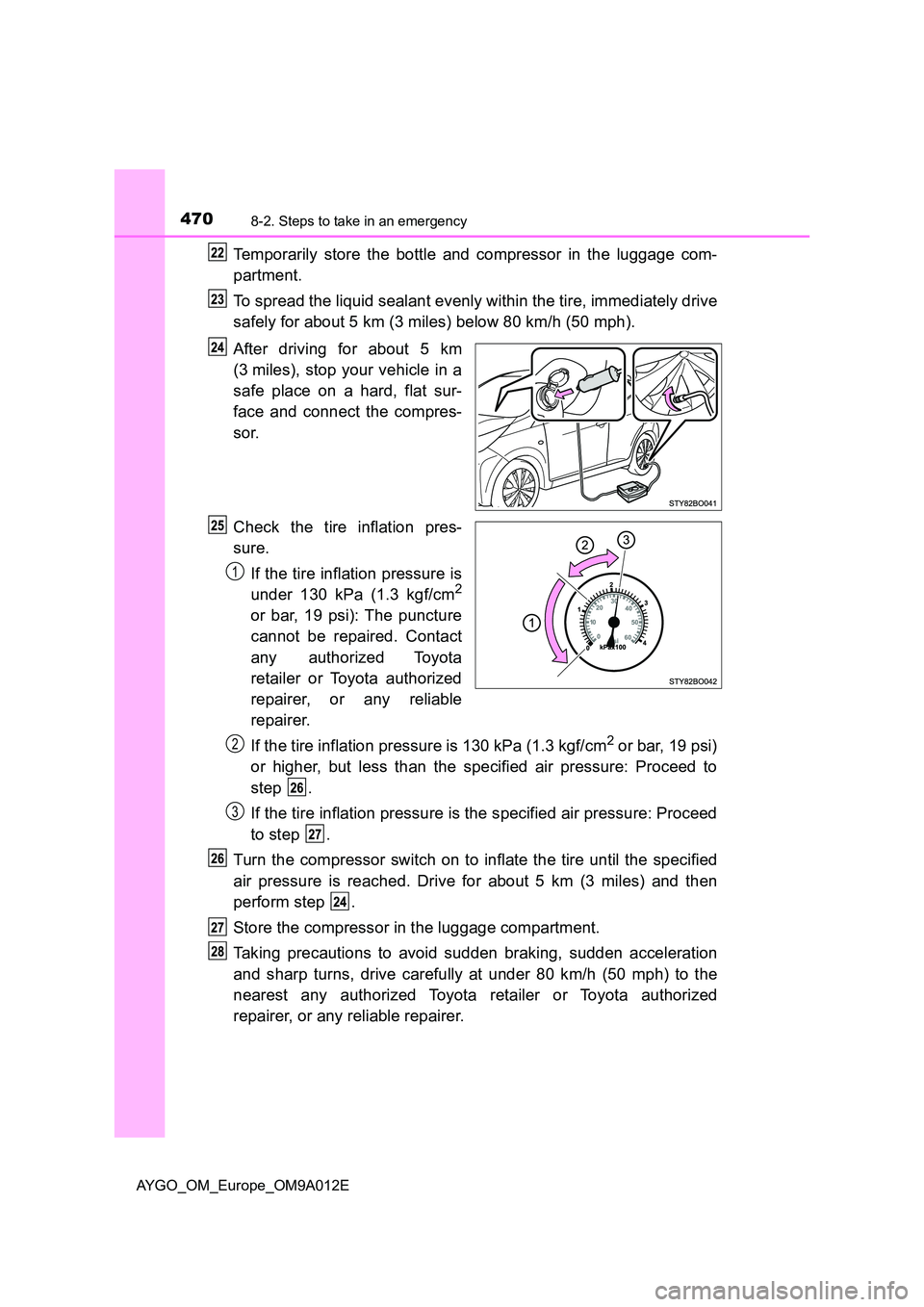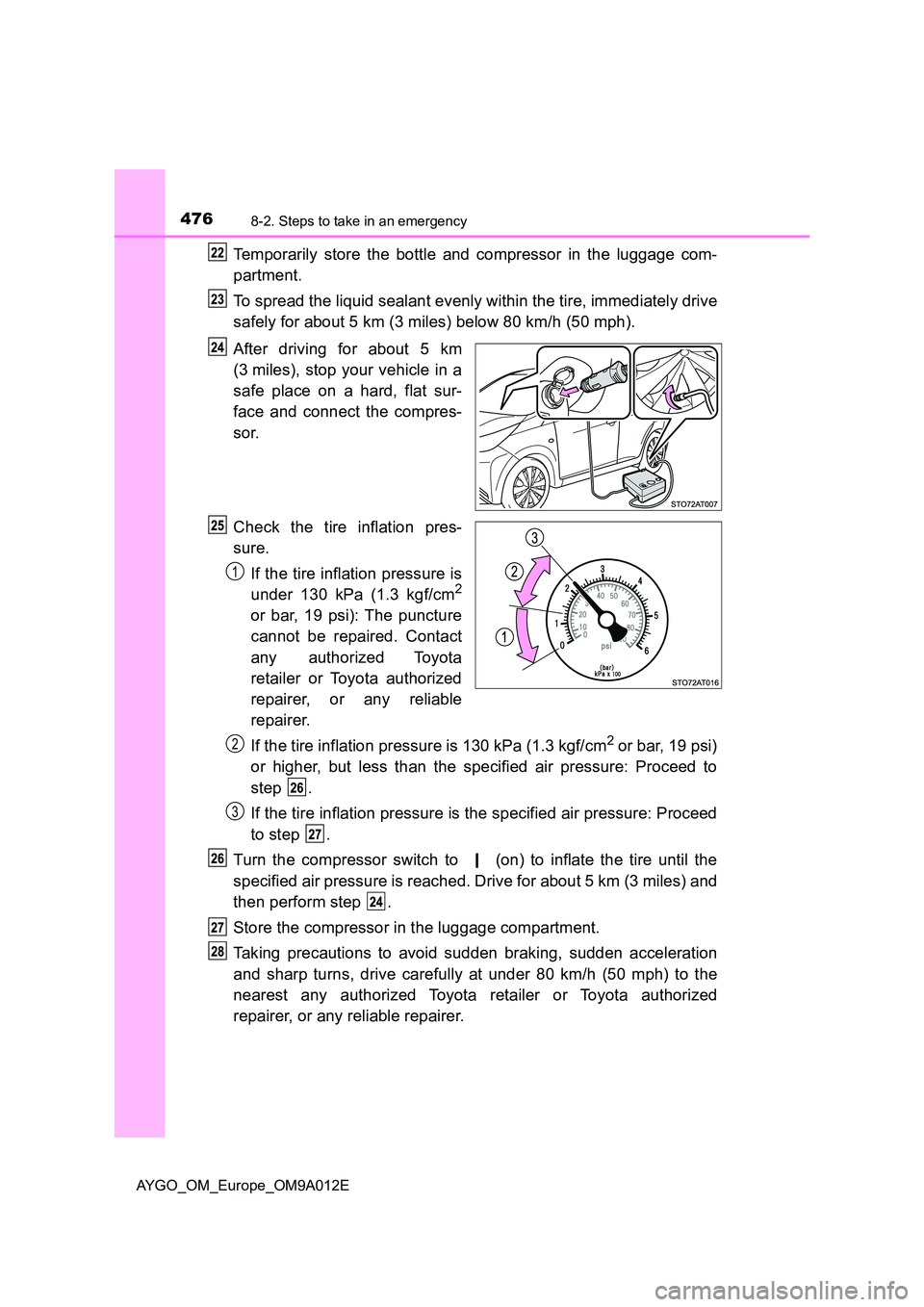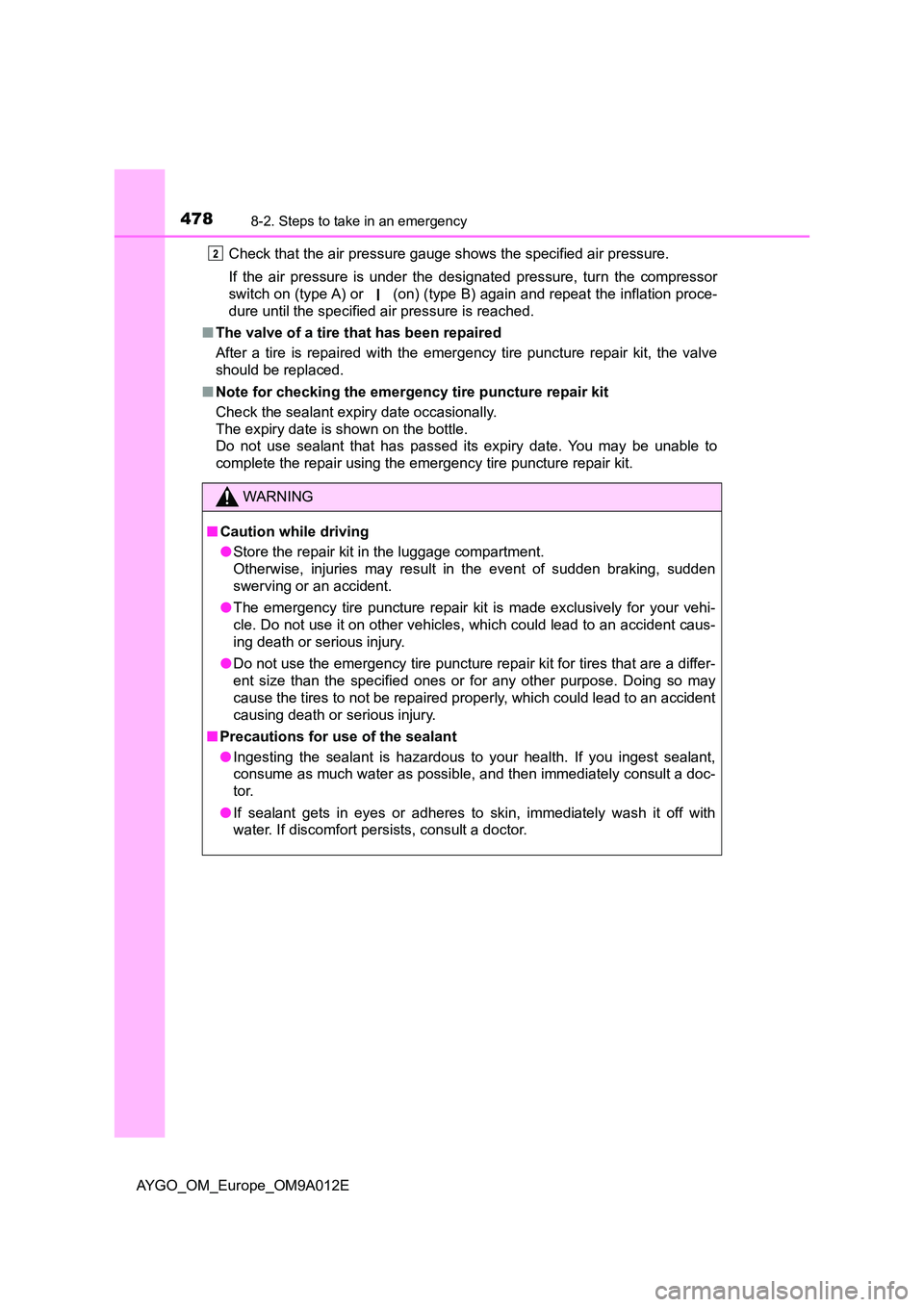Page 458 of 546

4568-2. Steps to take in an emergency
AYGO_OM_Europe_OM9A012E
■ If the tire pressure warning light frequently comes on after blinking for
1 minute (vehicles with a tire pressure warning system)
If the tire pressure warning light frequently comes on after blinking for 1 min-
ute when the engine switch is turned on, have it checked by any authorized
Toyota retailer or Toyota authorized repairer, or any reliable repairer.
■ Warning buzzer
In some cases, the buzzer may not be heard because of noisy place or an
audio sound.
WARNING
■ If both the ABS and the brake system warning lights remain on
Stop your vehicle in a safe place immediately and contact any authorized
Toyota retailer or Toyota authorized r epairer, or any reliable repairer. The
vehicle will become extremely unstable during braking, and the ABS system
may fail, which could cause an accident resulting in death or serious injury.
■ When the electric power steering system warning light comes on
The steering wheel may become extremely heavy.
When steering wheel operations are heavier than usual, grip the steering
wheel firmly and operate it using more force than usual.
■ If the tire pressure warning light comes on (vehicles with the tire pres-
sure warning system)
Be sure to observe the following precautions. Failure to do so could cause a
loss of vehicle control and result in death or serious injury.
● Stop your vehicle in a safe place as soon as possible. Adjust the tire infla-
tion pressure immediately.
● If the tire pressure warning light comes on even after tire inflation pressure
adjustment, it is probable that you have a flat tire. Check the tires. If a tire
is flat, change it with the spare tire and have the flat tire repaired by the
nearest any authorized Toyota retailer or Toyota authorized repairer, or
any reliable repairer.
● Avoid abrupt maneuvering and braking. If the vehicle tires deteriorate, you
could lose control of the steering wheel or the brakes.
■ If a blowout or sudden air leakage should occur (vehicles with the tire
pressure warning system)
The tire pressure warning system may not activate immediately.
NOTICE
■ To ensure the tire pressure warning system operates properly (vehi-
cles with the tire pressure warning system)
Do not install tires with different specif ications or makers, as the tire pres-
sure warning system may not operate properly.
Page 469 of 546
4678-2. Steps to take in an emergency
8
When trouble arises
AYGO_OM_Europe_OM9A012E
Make sure that the compressor
switch is off.
Remove the power plug from
the compressor.
Connect the power plug to the
power outlet socket. ( P. 376)
Check the specified tire inflation
pressure.
Tire inflation pressure is specified
on the label as shown. ( P. 518)
Start the engine. (P. 214, 217)
Page 470 of 546
4688-2. Steps to take in an emergency
AYGO_OM_Europe_OM9A012E
To inject the sealant and inflate
the tire, turn the compressor
switch on.
Inflate the tire until the specified
air pressure is reached.
The sealant will be injected
and the pressure will surge
and then gradually
decrease.
The air pressure gauge will
display the actual tire infla-
tion pressure about 1 minute
(5 minutes at low tempera-
ture) after the switch is
turned on.
Inflate to specified air pres-
sure.
• If the tire inflation pressure is still lower than the specified point after
inflation for 35 minutes with the switch on, the tire is too damaged to
be repaired. Turn the compressor switch off and contact any autho-
rized Toyota retailer or Toyota authorized repairer, or any reliable
repairer.
• If the tire inflation pressure exceeds the specified air pressure, let out
some air to adjust the tire inflation pressure. ( P. 477, 518)
1
2
3
Page 472 of 546

4708-2. Steps to take in an emergency
AYGO_OM_Europe_OM9A012E
Temporarily store the bottle and compressor in the luggage com-
partment.
To spread the liquid sealant evenly within the tire, immediately drive
safely for about 5 km (3 miles) below 80 km/h (50 mph).
After driving for about 5 km
(3 miles), stop your vehicle in a
safe place on a hard, flat sur-
face and connect the compres-
sor.
Check the tire inflation pres-
sure.
If the tire inflation pressure is
under 130 kPa (1.3 kgf/cm2
or bar, 19 psi): The puncture
cannot be repaired. Contact
any authorized Toyota
retailer or Toyota authorized
repairer, or any reliable
repairer.
If the tire inflation pressure is 130 kPa (1.3 kgf/cm2 or bar, 19 psi)
or higher, but less than the specified air pressure: Proceed to
step .
If the tire inflation pressure is the specified air pressure: Proceed
to step .
Turn the compressor switch on to inflate the tire until the specified
air pressure is reached. Drive for about 5 km (3 miles) and then
perform step .
Store the compressor in the luggage compartment.
Taking precautions to avoid sudden braking, sudden acceleration
and sharp turns, drive carefully at under 80 km/h (50 mph) to the
nearest any authorized Toyota retailer or Toyota authorized
repairer, or any reliable repairer.
1
2
3
Page 475 of 546
4738-2. Steps to take in an emergency
8
When trouble arises
AYGO_OM_Europe_OM9A012E
Make sure that the compressor
switch is (off).
Remove the power plug from
the compressor.
Connect the power plug to the
power outlet socket. ( P. 376)
Check the specified tire inflation
pressure.
Tire inflation pressure is specified
on the label as shown. ( P. 518)
Start the engine. (P. 214, 217)
Page 476 of 546
4748-2. Steps to take in an emergency
AYGO_OM_Europe_OM9A012E
To inject the sealant and inflate
the tire, turn the compressor
switch to (on).
Inflate the tire until the specified
air pressure is reached.
The sealant will be injected
and the pressure will surge
and then gradually
decrease.
The air pressure gauge will
display the actual tire infla-
tion pressure about 1 minute
(5 minutes at low tempera-
ture) after the switch is
turned (on).
Inflate to specified air pres-
sure.
• If the tire inflation pressure is still lower than the specifi ed point after
inflation for 35 minutes with the switch at (on), the tire is too
damaged to be repaired. Turn the compressor switch to (off) and
contact any authorized Toyota retailer or Toyota authorized rep airer,
or any reliable repairer.
• If the tire inflation pressure exceeds the specified air press ure, let out
some air to adjust the tire inflation pressure. ( P. 477, 518)
1
2
3
Page 478 of 546

4768-2. Steps to take in an emergency
AYGO_OM_Europe_OM9A012E
Temporarily store the bottle and compressor in the luggage com-
partment.
To spread the liquid sealant evenly within the tire, immediatel y drive
safely for about 5 km (3 miles) below 80 km/h (50 mph).
After driving for about 5 km
(3 miles), stop your vehicle in a
safe place on a hard, flat sur-
face and connect the compres-
sor.
Check the tire inflation pres-
sure.
If the tire inflation pressure is
under 130 kPa (1.3 kgf/cm2
or bar, 19 psi): The puncture
cannot be repaired. Contact
any authorized Toyota
retailer or Toyota authorized
repairer, or any reliable
repairer.
If the tire inflation pressure is 130 kPa (1.3 kgf/cm2 or bar, 19 psi)
or higher, but less than the specified air pressure: Proceed to
step .
If the tire inflation pressure is the specified air pressure: P roceed
to step .
Turn the compressor switch to (on) to inflate the tire until the
specified air pressure is reached. Drive for about 5 km (3 mile s) and
then perform step .
Store the compressor in the luggage compartment.
Taking precautions to avoid sudden braking, sudden acceleration
and sharp turns, drive carefully at under 80 km/h (50 mph) to t he
nearest any authorized Toyota retailer or Toyota authorized
repairer, or any reliable repairer.
1
2
3
Page 480 of 546

4788-2. Steps to take in an emergency
AYGO_OM_Europe_OM9A012E
Check that the air pressure gauge shows the specified air pressure.
If the air pressure is under the designated pressure, turn the compressor
switch on (type A) or (on) (type B) again and repeat the inflation proce-
dure until the specified air pressure is reached.
■ The valve of a tire that has been repaired
After a tire is repaired with the emer gency tire puncture repair kit, the valve
should be replaced.
■ Note for checking the emergency tire puncture repair kit
Check the sealant expiry date occasionally.
The expiry date is shown on the bottle.
Do not use sealant that has passed its expiry date. You may be unable to
complete the repair using the emergency tire puncture repair kit.
WARNING
■ Caution while driving
● Store the repair kit in the luggage compartment.
Otherwise, injuries may result in the event of sudden braking, sudden
swerving or an accident.
● The emergency tire puncture repair kit is made exclusively for your vehi-
cle. Do not use it on other vehicles, which could lead to an accident caus-
ing death or serious injury.
● Do not use the emergency tire puncture repair kit for tires that are a differ-
ent size than the specified ones or for any other purpose. Doing so may
cause the tires to not be repaired properly, which could lead to an accident
causing death or serious injury.
■ Precautions for use of the sealant
● Ingesting the sealant is hazardous to your health. If you ingest sealant,
consume as much water as possible, and then immediately consult a doc-
tor.
● If sealant gets in eyes or adheres to skin, immediately wash it off with
water. If discomfort persists, consult a doctor.